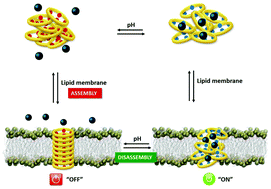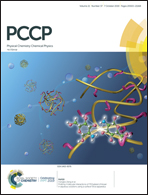Competitive double-switched self-assembled cyclic peptide nanotubes: a dual internal and external control†
Abstract
“Intelligent” materials based on synthetic small molecules that become functional only under specific conditions provide new opportunities for developing regulated systems aimed at a large number of applications. For instance, biologically active supramolecular entities that are sensitive to environmental conditions, such as the presence of bacterial membranes, are extremely interesting in biomedicine. In this work, we have designed and investigated, using molecular dynamics simulations, a doubly modulable nanotube formed by the self-assembly of cyclic peptides sensitive to both the presence of a lipid membrane and the pH of the aqueous media. The cyclic peptides were designed to self-assemble into peptide nanotubes in the presence of a lipid bilayer and at low pH values. Under these conditions, the residual side chains point outside the cyclic peptides, being exposed to the lipid bilayer, and the inner groups (carboxylic acids) are protonated, thus allowing the permeation of water and preventing that of ions. Higher pH values are expected to create carboxylate groups at the lumen of the peptides, leading to the disassembly of the nanotube, the attraction and translocation of ions towards the hydrophobic core of the bilayer, and eventually killing the target malignant cells. Our results suggest that by introducing a second switch in a membrane sensitive system, it is possible to modulate its interaction with the lipid bilayer. This opens the door to new strategies for the preparation of antimicrobial peptides that interact at the membrane level.



 Please wait while we load your content...
Please wait while we load your content...